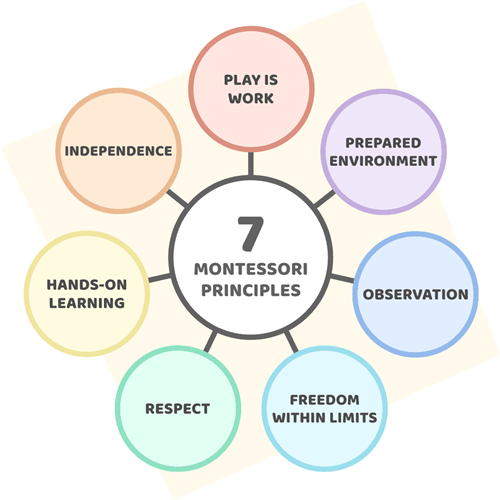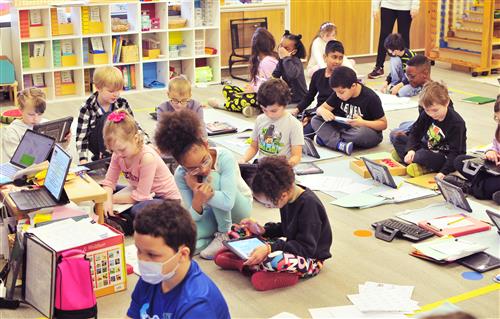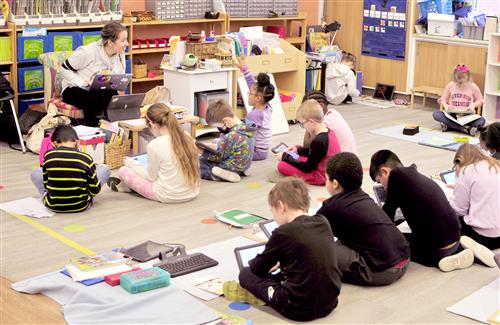- Montessori Academy for Peace
- Academics at MAP
What is Montessori?
-
 For more than a century now, the child-focused approach that Dr. Maria Montessori, an Italian physician, developed for educating children has been transforming schools around the globe.
For more than a century now, the child-focused approach that Dr. Maria Montessori, an Italian physician, developed for educating children has been transforming schools around the globe.As soon as you enter a classroom, you know that something different is afoot. Montessori classrooms are immediately recognizable. You will see children working independently and in groups, often with specially designed learning materials; deeply engaged in their work; and respectful of themselves and their surroundings.
The Montessori Method fosters rigorous, self-motivated growth for children and adolescents in all areas of their development—cognitive, emotional, social, and physical. Montessori education is student-led and self-paced but guided, assessed, and enriched by knowledgeable and caring teachers, the leadership of their peers, and a nurturing environment.
Within the community of a multi-age classroom—designed to create natural opportunities for independence, citizenship, and accountability—children embrace multi-sensory learning and passionate inquiry. Individual students follow their own curiosity at their own pace, taking the time they need to fully understand each concept and meet individualized learning goals.
Source: American Montessori Society
Classroom Structure at MAP
Our Early Childhood classrooms consist of three- and four-year-old students, plus those who would traditionally be in Kindergarten. The time between the ages of three and six is most important in building the foundation for all knowledge that follows. During this time, the child possesses an "Absorbent Mind" and can learn seemingly without effort. At no other time in a child's life will he/she be able to readily absorb language, reading, writing, and build a mathematical mind. The materials in the classrooms are designed to paint pictures in the students' minds that will serve as references in their later works.
 Elementary I classrooms are composed of six- to nine-year-old students. Traditionally this would be first, second, and third grades. During this phase of development, students use the cultural area of the classroom to drive their learning. Their constant desire to know more about the real world, its peoples, geography, and history launches them into their research and learning. Montessori lessons always begin with the real object whenever possible, which captures the mind and attention of the young learner. By providing this rich environment, students eagerly approach their studies and therefore take great pride in their projects and accomplishments. Elementary I students are characterized by a bubbling over to share their latest knowledge with their community, directress, and principal.
Elementary I classrooms are composed of six- to nine-year-old students. Traditionally this would be first, second, and third grades. During this phase of development, students use the cultural area of the classroom to drive their learning. Their constant desire to know more about the real world, its peoples, geography, and history launches them into their research and learning. Montessori lessons always begin with the real object whenever possible, which captures the mind and attention of the young learner. By providing this rich environment, students eagerly approach their studies and therefore take great pride in their projects and accomplishments. Elementary I students are characterized by a bubbling over to share their latest knowledge with their community, directress, and principal.Following the three years of Elementary I is the Elementary II curriculum. This is designed for students between the ages of nine and twelve. During these three years, students delve deeper into their mathematics looking for patterning in numbers and operations. Elementary II students are curious to see if they can discover alternate ways of getting the same solution such as different filters to find all the prime numbers between one and four hundred. This creative problem solving will serve them well as they continue to work with others in teams. One unique characteristic of Montessori education is providing students with a control of error. As a student works with a material or after its completion, a child may go to the shelf and find an answer key. This way the child can correct his/her own work and learn from any mistakes they may have made. In Montessori, a work is done until it is perfect. You may have heard that some Montessori schools do not give grades. This is because a child does a work repeatedly until they have mastered the concept. Great self-confidence is attained in this way, and now the student knows he or she can teach other student the same way. Cooperation in work is encouraged rather than discouraged so the concept of "cheating" is foreign in a Montessori classroom.
 Montessori Academy for Peace is the only school in the state of Illinois to offer a Montessori-based program for Middle School students. The middle school curriculum uses time periods to study the fundamental human needs and how cultures, empires, and countries have responded to those needs throughout time. Literature circles are employed as a means to extend those cultural studies into historical fiction of the period. In this way the adolescent connects with the protagonist in the stories and sees the events through their eyes. This builds a profound sense of tolerance, empathy, and leads to understanding. Our middle school students study either a two year pre-algebra or algebra I program. Many of our sixth year Elementary II students are invited to study math with the middle school students. A Montessori education is about following the needs of the child rather than a set curriculum. By observing the tendencies and behaviors of a student, a director/directress can determine what course of study the student needs.
Montessori Academy for Peace is the only school in the state of Illinois to offer a Montessori-based program for Middle School students. The middle school curriculum uses time periods to study the fundamental human needs and how cultures, empires, and countries have responded to those needs throughout time. Literature circles are employed as a means to extend those cultural studies into historical fiction of the period. In this way the adolescent connects with the protagonist in the stories and sees the events through their eyes. This builds a profound sense of tolerance, empathy, and leads to understanding. Our middle school students study either a two year pre-algebra or algebra I program. Many of our sixth year Elementary II students are invited to study math with the middle school students. A Montessori education is about following the needs of the child rather than a set curriculum. By observing the tendencies and behaviors of a student, a director/directress can determine what course of study the student needs.Our middle school students also enjoy choir, Spanish, band, string orchestra, and extra curricular sports. Sports offerings include cross country, soccer, basketball, volleyball, track, pom pons, and cheerleading. Montessori Academy for Peace is a member of the IESA and adheres to all the guidelines contained within. In a Montessori environment, we try to encourage students to research and form their own organizations and clubs according to their personal interests and talents. To the best of our ability we try to adhere to a "no cut" policy so that all students can participate in the activity of their choosing.

